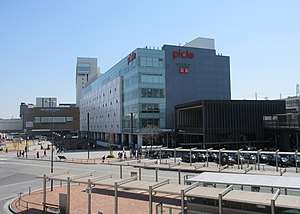Himeji Station
Himeji Station (姫路駅, Himeji-eki) is a railway station in Himeji, Japan, operated by West Japan Railway Company (JR West). Himeji is a major stop on the Sanyō Main Line, and the western end of the JR Kobe Line. The station serves as a connection point between the main line and the Sanyō Shinkansen, the Kishin Line and the Bantan Line.
Himeji Station 姫路駅 | |
|---|---|
 The north side of the station in March 2020 | |
| Location | 188 Ekimaecho, Himeji-shi, Hyōgo-ken Japan |
| Coordinates | 34°49′39.5″N 134°41′27.06″E |
| Operated by | |
| Line(s) |
|
| Connections | |
| History | |
| Opened | 1888 |
| Location | |
 Himeji Station Location within Japan | |
The station building is located close to the Sanyo Electric Railway Himeji Station and Himeji Castle.
Station layout

The preparation for elevation of the conventional lines has been undertaken since 1989, and begun in earnest in 1994 after the relocation of Himeji's freight terminal and train yards. On March 26, 2006, platforms for the JR Kobe Line and Sanyo Main Line switched to the elevated railway, while the remainder of the platforms, for the Bantan and Kishin Lines, were elevated beginning on December 22, 2008. Removal of ground platforms and the remainder of reconstruction work is planned to conclude in 2010.
Platforms
| 1, 2 | ■ Bantan Line | for Teramae, Wadayama |
|---|---|---|
| 2 | □ Limited Express Hamakaze | for Ōsaka (JR Kobe Line) |
| 3, 4 | ■ Kishin Line | for Harima-Shingū, Sayo |
| 5, 6 | ■ JR Kobe Line (Sanyō Main Line) (eastbound) | for Kakogawa, Sannomiya, Ōsaka |
| 5 | □ Limited Express Super Hakuto (eastbound) | for Osaka |
| □ Overnight limited express Sunrise Izumo/Sunrise Seto | for Shizuoka, Yokohama, Tokyo | |
| 7, 8 | ■ Sanyō Main Line (westbound) | for Aioi, Banshu-Ako, Kamigori, Okayama |
| □ Limited Express Super Hakuto (westbound) | for Tottori via the Chizu Express Line | |
| 7 | □ Limited Express Hamakaze | for Kinosaki Onsen via the Bantan Line |
| 8 | □ Overnight limited express Sunrise Izumo/Sunrise Seto | for Takamatsu, Yonago, Matsue, Izumoshi |
| Shinkansen platforms | ||
| 11 | ■ Sanyo Shinkansen (eastbound) | for Shin-Osaka, Nagoya, and Tokyo |
| 12, 13 | ■ Sanyo Shinkansen (westbound) | for Okayama, Hakata, and Kagoshima-Chūō |
| ■ Sanyo Shinkansen (eastbound) | starting for Shin-Osaka and Tokyo | |
History
Himeji Station was opened by Sanyo Railway, the present-day Sanyo Main Line, in 1888. At the time, railway stations were usually built either outside or alongside urban areas,[1] but Himeji Station was built bordering the old city walls, at the end of the main street (Ootemae-dori). The current Sanyo Railway Station is actually constructed on top of part of the old city wall.[2] It is thought that the reason was that the army was based in Himeji Castle. This proximity to the city helped to contribute to urban development.[3]
Himeji Station was linked to Bantan Railway (播但鉄道, Bantan Tetsudō), the present day Bantan Line, in 1894. Kishin Line was linked to the station in 1930.
The station was expanded with the opening of the Sanyo Shinkansen in 1972.
Timeline
- December 23, 1888: The Sanyo Railway segment between Akashi Station and Himeji Station opens.
- July 26, 1894: The Bantan Railway segment between Himeji Station and Teramae Station opens.
- June 1, 1903: Sanyo Railway purchases Bantan Railway.
- December 1, 1906: Sanyo Railway is nationalized.
- September 1, 1930: Kishin Line is connected.
- March 15, 1972: The Sanyo Shinkansen segment between Okayama and Shin-Osaka opens.
- April 1, 1987: Japanese National Railways is divided and privatized. The line is taken over by the West Japan Railway Company.
- January 17, 1995: There was a blockage of the segment of the Sanyō Shinkansen between Shin-Osaka and Himeji, caused by the Great Hanshin earthquake.
- April 8, 1995: The blocked section reopens.
- October 1, 2003: Nozomi service is added to the schedule.
- March 15, 2014: Mizuho service is added to the schedule.
Adjacent stations
| « | Service | » | ||
|---|---|---|---|---|
| Sanyo Shinkansen | ||||
| Nishi-Akashi or Shin-Kobe |
Nozomi | Okayama | ||
| Nishi-Akashi or Shin-Kobe |
Hikari | Aioi or Okayama | ||
| Nishi-Akashi | Kodama | Aioi | ||
| Shin-Kobe | Mizuho | Okayama | ||
| Shin-Kobe | Sakura | Okayama | ||
| Sanyo Main Line (JR Kobe Line) | ||||
| Hamamatsu CA34 (westbound) Sannomiya (JR-A61) (eastbound) |
Sleeper Limited Express Sunrise Seto & Sunrise Izumo |
Okayama | ||
| Akashi (JR-A73) Kakogawa (JR-A79) (No. 13 only) |
Limited Express Super Hakuto |
Aioi or Kamigori | ||
| Kakogawa (JR-A79) | Commuter Limited Express Rakuraku Harima |
Terminus | ||
| Kakogawa (JR-A79) | Special Rapid Service | Agaho | ||
| Higashi-Himeji (JR-A84) | Local (Rapid Service) | Agaho | ||
| Bantan Line | ||||
| Akashi (JR-A73) Kakogawa (JR-A79) (No. 5 only) |
Limited Express Hamakaze |
Fukusaki | ||
| Terminus | Local | Kyoguchi | ||
| Kishin Line | ||||
| Terminus | Local | Harima-Takaoka | ||
See also
References
| Wikimedia Commons has media related to Himeji Station. |
- "A comparative study of the relation between the elevated railroad project and urban area development in western-part-of-Japan (Kochi University of Technorogy Library)" (PDF) (in Japanese). Archived from the original (PDF) on 2005-04-13. Retrieved February 22, 2007.
- "Outline of Himeji castle" (in Japanese). Himeji Information Web site. Retrieved February 22, 2007.
- "Master plan of Himeji city" (in Japanese). Himeji city office. Archived from the original on February 8, 2007. Retrieved February 22, 2007.